Memory Scaling on Haswell CPU, IGP and dGPU: DDR3-1333 to DDR3-3000 Tested with G.Skill
by Ian Cutress on September 26, 2013 4:00 PM ESTOur final set of tests are a little more on the esoteric side, using a tri-GPU setup with a HD5970 (dual GPU) and a HD5870 in tandem. While these cards are not necessarily the newest, they do provide some interesting results – particularly when we have memory accesses being diverted to multiple GPUs (or even to multiple GPUs on the same PCB). The 5970 GPUs are clocked at 800/1000, with the 5870 at 1000/1250.
Dirt 3: Average FPS
It is pretty clear that memory has an effect: +13% moving from 1333 C9 to 2133 C9/2400 C10. In fact, that 1333 C9 seems to be more of a sink than anything else – above 2133 MHz memory the performance benefits are minor at best. It all depends if 186.53 FPS is too low for you and you need 200+.
Dirt 3: Minimum FPS
We see a similar trend in minimum FPS for Dirt3: 1333 C9 is a sink, but moving to 2133 C9/2400 C10 gives at least a 20% jump in minimum frame rates.
Bioshock Infinite: Average FPS
While differences in Bioshock Infinite Minimum FPS are minor at best, 1333 MHz and 1600 C10/C11 are certainly at the lower end. Anything 1866 MHz or 2133 MHz seems to be the best bet here, especially in our case if we wanted to push for 120 FPS gaming.
Bioshock Infinite: Minimum FPS
Similar to Bioshock on IGP, minimum frame rates across the board seem to be very low, with minor differences giving large % rises.
Tomb Raider: Average FPS
Tomb Raider remains resilient to change across our benchmarks, with 1 FPS difference between the top and bottom average FPS results in our tri-GPU setup.
Tomb Raider: Minimum FPS
With our tri-GPU setup being a little odd (two GPUs on one PCB), Tomb Raider cannot seem to find much consistency for minimum frame rates, showing up to a 15% difference when compared to our 1600 C10 result which seems to be a lot lower than the rest.
Sleeping Dogs: Average FPS
Similar to other results, 1333 and 1600 MHz results give lower frame rates, along with the slower 1866 MHz C10/C11 options. Anything 2133 MHz and above gives up to 8% more performance than 1333 C9.
Sleeping Dogs: Minimum FPS:
Minimum frame rates are a little random in our setup, except for one constant – 1333 MHz memory does not perform. Everything beyond that seems to be at the whim of statistical variance.


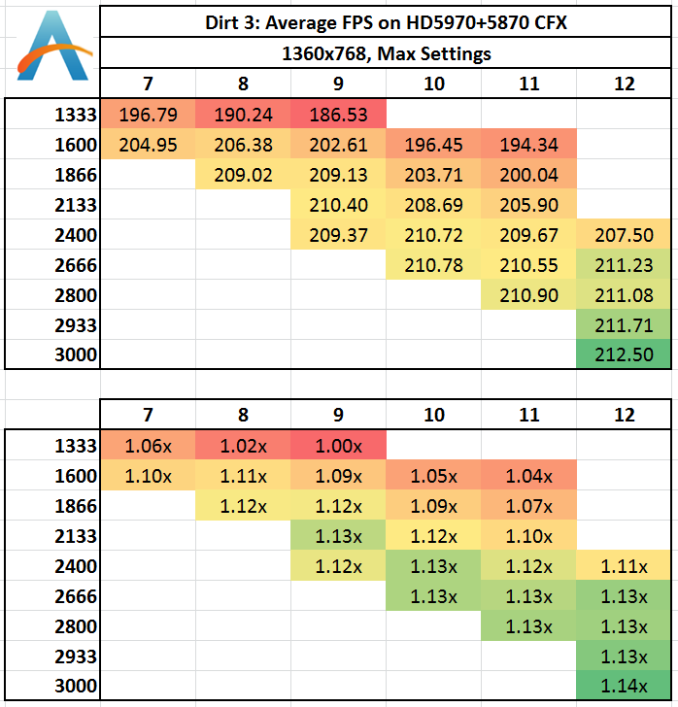
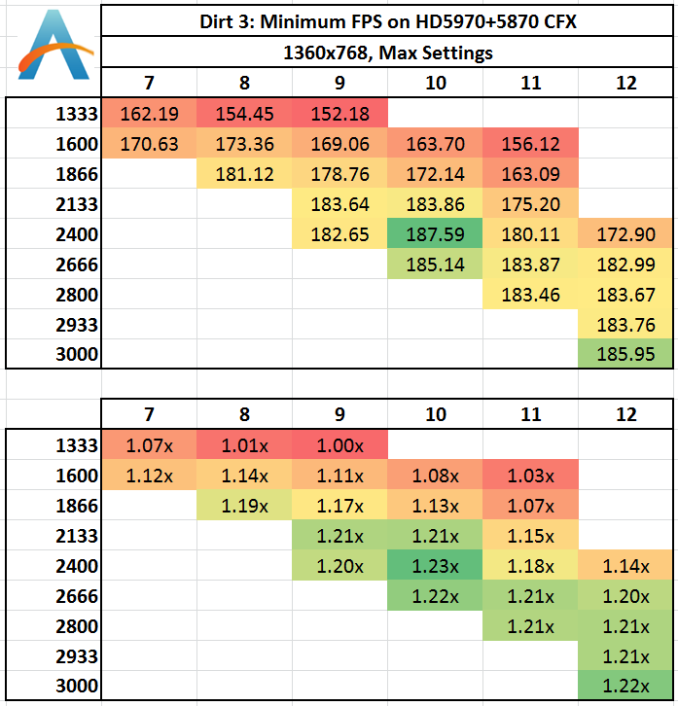

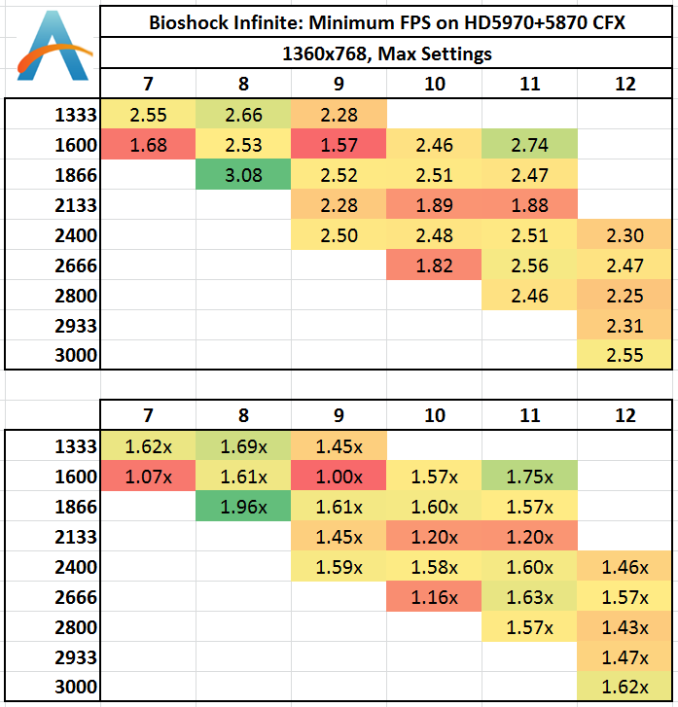
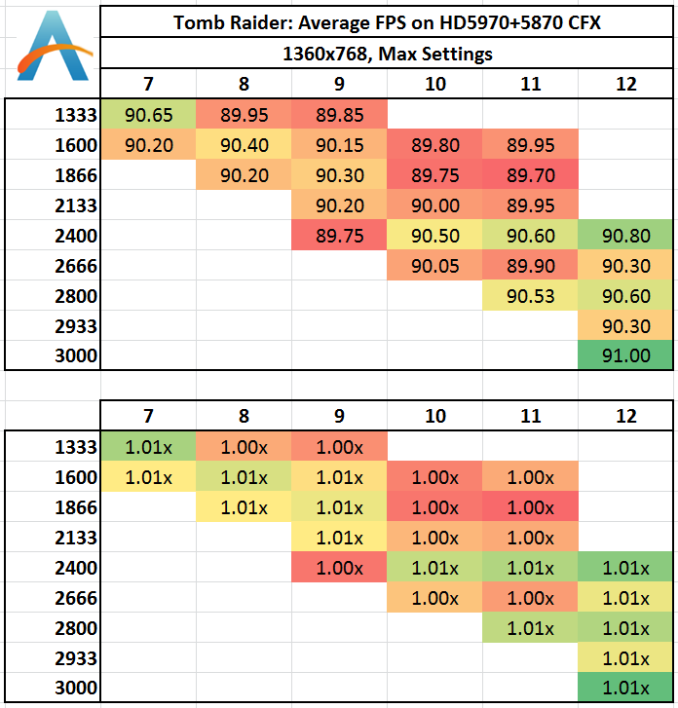

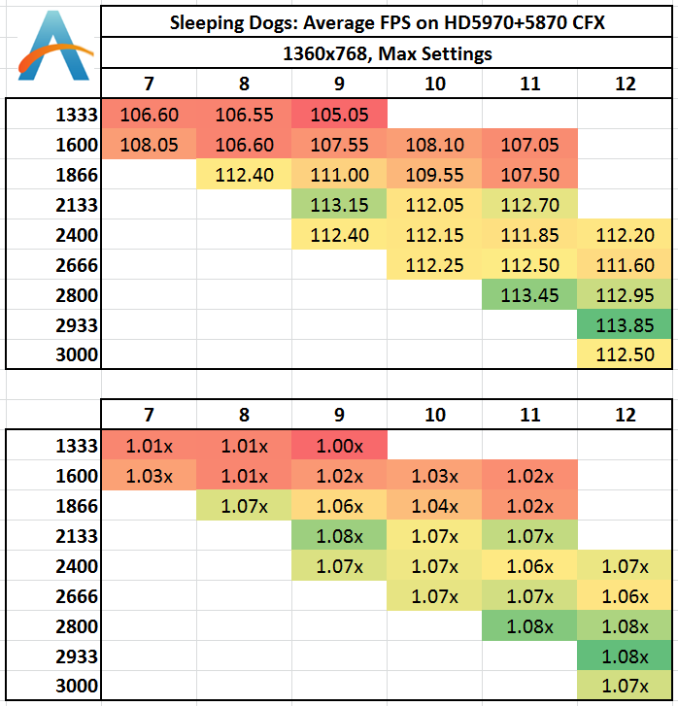
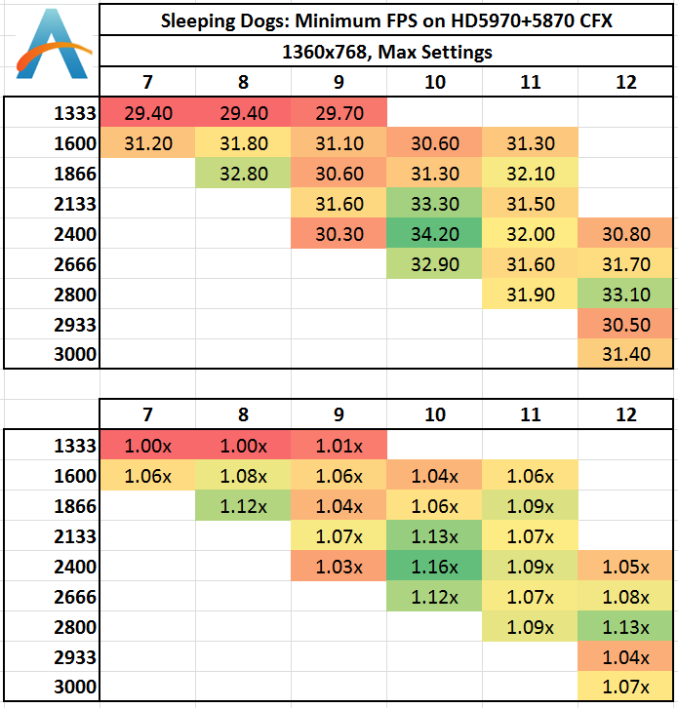








89 Comments
View All Comments
tynopik - Thursday, September 26, 2013 - link
colors reversed on USB 3.0 Copy Test chart where green is given to the highest (worst) results and red is given to the lowest (best) resultsTegeril - Thursday, September 26, 2013 - link
These are the most colorblind-unfriendly images I've seen to date on this site.Razorbak86 - Friday, September 27, 2013 - link
You tell 'em, bro! Too bad he didn't put actual NUMBERS in the cells, instead of all those non-readable colors. ;)QChronoD - Friday, September 27, 2013 - link
Please redo the IGP gaming benchmarks with playable settings. All you did was waste your time testing at unreasonably high detail and not proven a single thing about whether the extra bandwidth is able to help increase performance.pdjblum - Friday, September 27, 2013 - link
Awesome work. Man, this must have taking forever, even with fast memory. Thanks so much.adityarjun - Friday, September 27, 2013 - link
CAS Latency is given as 6-7-8-9-10-11. What does that mean?http://www.flipkart.com/transcend-jetram-ddr3-8-gb...
Any help on which of these would be better and why?
http://www.flipkart.com/computers/computer-compone...
anton68 - Friday, September 27, 2013 - link
It'd be nice to see how the Iris Pro eDRAM affects compute performance when used as an L4 cache.pjdaily - Saturday, September 28, 2013 - link
I'd like to see this test too.MadAd - Friday, September 27, 2013 - link
Hi Ian, thanks for the review, could you explain the thinking behind using only 1360x768 for the gaming tests, especially for the single card benchmarks? Would stretching the single card with a memory intensive game at a high resolution change the results more towards IGPU fractions?This is more the scenario I would expect gamers to be facing and even if the answer turns out to be no, that in itself would be valuable data to learn.
merikafyeah - Friday, September 27, 2013 - link
Please, please, please incorporate some ramdisk benchmarks for these memory tests. It seems like such a given but no one seems to think of this, which is essentially the only test where you'll see some major differences between speed tiers. Things like gaming don't really result in differences worth your money.I recommend Primo Ramdisk for its rock-solid stability but if you're looking for a free alternative I recommend SoftPerfect RAM Disk, which has been noted to be significantly faster than Primo, but may not be as stable under certain circumstances.